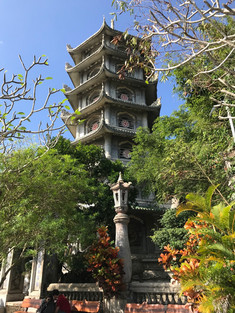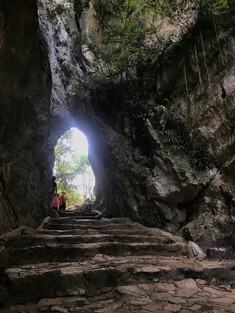
A frigid hello from Iowa!
We currently have lots of snow and plenty of cold temperatures. As I reflect on my locale at this time last year, I can’t say that I missed this annual white wintry mess we in the Midwest have learned to endure. When fellow travelers inquired about what the climate was like where I came from in the middle of America, I would share that we truly have it all. During the winter months we experience a frozen tundra, spring and fall resemble more temperate climates, and in the summer we get the heat and humidity rivaling even that of Southeast Asia. I do love my home state very much, but loathe being cold and much prefer the heat and humidity which southern Vietnam has plenty of.
In my last post I was living it up in beautiful Hoi An. I stayed in a nice little family run guest house within walking distance to the old town. My hostess, a local, born and raised in Hoi An, provided great recommendations for my time there as well as for my next leg of the journey to the ancient city of Hue. The journey to Hue was about a 3 hour drive. I could have easily taken a bus, but I had heard about a more scenic route best experienced on a motorbike through Vietnam’s Hai Van Pass. This 21km coastal drive through the mountains is known as one of the most beautiful coastal drives not only in Vietnam but the world. This pass is also known for being a dangerous drive due to often foggy and misty conditions caused by the sea and the curvy mountain coastal roads. I was not at all interested in driving myself, so instead hired an “easy rider.” An easy rider is a hired motorcycle driver and private tour guide all in one. For about 40 US dollars I had my transportation covered and an 8 hour private tour guide (I also had to pay for my lunch and some modest entrance fees at some of our stops). My hostess made the arrangements and my driver/tour guide Tim showed up outside my guesthouse the next morning. Tim tied my backpack securely to the back of his motorcycle (another reason why traveling light is the only way to go), handed me a helmet and we were off. We left Hoi An driving through Da Nang to our first stop at Thuy Son Marble Mountain. Thuy Son boasts a beautiful Pagoda perched at the top of the mountain, along with temples and caves to explore.
We continued along the coast and as we drove higher on roads that tightly hugged the mountainside, I found myself grinning ear to ear as the warm air hit my face and I tried to absorb the beauty that could be seen in every direction. I had lucked out with a warm, sunny day for this ride. Many Easy Riders make this journey, rain or shine, providing rain jackets and rain pants for their riders as well as ensuring all luggage is sufficiently covered. I am beyond happy none of this was necessary for my ride.

The blue sky met the blues of the ocean below us, broken up by lush green foliage draping across the mountain. We made several stops to take pictures and take-in the panoramic
views. We stopped at a well-preserved French military bunker which was later used by the Americans during the war. We made our way down the mountain and had a late lunch in a quiet town at a small, shabby, open air eatery set on stilts on the beachfront. I am not a seafood fan (I can hear the seafood lovers groaning in disappointment...I get that a lot!) and settled for an excellent, spicy chicken fried rice. If you do eat seafood this place apparently serves up the goods.
After lunch, we drove by oyster farms where I learned about this relatively new and booming industry in northern Vietnam and some of the challenges, such as oyster thieves. Oyster farming has become a lucrative business, which creates the temptation for thieves to steal the oysters at night. To protect against this there are many modest huts set-up in the middle of the water where farmers stay at night in an attempt to keep watch and thwart off any potential oyster thieves.
Our next stop was Elephant Springs, a popular swimming hole for locals and backpackers alike, tucked away down a series of long, narrow, partially shaded, very broken roads. It was mid-afternoon when we arrived and the warmth of the afternoon sun began to wane with temperatures at a brisk 70 degrees Fahrenheit (21 Celsius). With these cooler temperatures and my swimsuit packed away, I had decided I would not swim, but my driver Tim insisted I would regret it if I didn’t. I knew he was right. I dug my swimsuit out, got changed and with the force of the rushing water took a ride down the large boulders on this nature-made “water slide.” I was dumped into the pool below and enjoyed some time swimming and conversing with other backpackers. I have read reviews where some complain this area has a large amount of trash strewn about, an unfortunate and frequent issue when traveling in Southeast Asia, but fortunately this was not the case the day I was there. The clear blue water and the beauty of the natural surroundings made this a refreshing and memorable stop.
Moving along on our journey, Tim took some more rural roads to a small settlement located on a quiet inlet on the water. Tim introduced me to communities where people live on incredibly small houseboats, sometimes with up to four people living on one of these boats. These boats are small, long, and narrow with a curved metal roof in the middle to provide shelter. You can see smoke where families are cooking on the boats, and laundry hanging to dry. Directly next to this inlet of water the government built rows of white houses creating this small settlement. These newly built houses were given to the families as well as jobs in an effort to relocate these families to life on land. I was told the majority had sold these decent sized government issued houses, kept the money and moved back to their lives on the water living in their small boats. As someone whose career has been working in the nonprofit and philanthropic sectors, this example was a good reminder on how important it is to work with communities when providing assistance to better understand them and ensure we are truly being helpful, not hurtful, and using limited resources in the best way possible.


From here we drove the rest of the way to Hue, our final destination was my Airbnb where I had rented a private room with a Vietnamese family for the next couple of nights. I cannot say enough good things about hiring an Easy Rider to explore the Hai Van Pass and the coast of Vietnam. My guide Tim was excellent and I greatly enjoyed getting to know him and the insight he provided on both his country and culture throughout the day. He ensured I felt safe throughout the journey and I was well-taken care of. I learned Tim was 26 years old, born in Hue, where his mom, dad and sister still lived. Traditionally in Vietnam, it is the oldest son’s duty to live with your parents, almost always in the home you were raised in. It is expected that the oldest son will marry and his new wife will move into his parent’s home with him with the expectation to care for his aging parents along with any children they may have. He shared with me that he was breaking with tradition having not yet married and had little interest, much to his mother’s dismay. He said he was fortunate because his sister and her husband, he not being the oldest son in his family, had decided to live with and care for their parents. He expressed gratitude for this as it freed him up to be able to do this job that he loves. Traditions are held strong here, but the next generation is seeking to find their own balance in upholding what is important to their families and what they as individuals hold to be important.

The Vietnamese people throughout their history were colonized or invaded by many foreign powers leading to a series of devastating wars and massive loss of life. It would be hard to blame them if they were skeptical and unkind to outsiders, but I found the opposite to be true. While I have found the Vietnamese people as a whole to be a bit more reserved than people of other Southeast Asian nations I've visited, I have found them to be kind and welcoming. Due to the war, many Americans have asked me how I was treated by the Vietnamese when they learned I was American. I have to say they were indifferent and those who did show interest were curious as to what I thought of their country and the war. I found the Vietnamese to be an incredibly resilient, hardworking and forgiving people. Many Americans still hold on to horrific images of Vietnam at war, but these images couldn't be further from the current reality. I saw a beautiful country that acknowledges its troubled past, but is more interested in moving confidently toward its bright future.
Get Busy Living!
Anna















